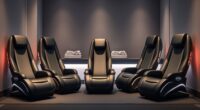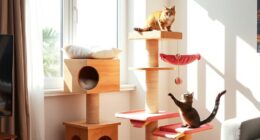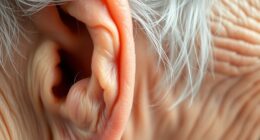Choosing between open-fit and custom mold hearing aids depends on your lifestyle and comfort preferences. Open-fit models are lightweight, discreet, and easy to use, ideal if you want natural sound and longer battery life. Custom molds offer a snug, secure fit, better noise isolation, and superior sound quality, especially for active routines. Consider what feels most comfortable and fits your daily needs—more details can help you make the best choice.
Key Takeaways
- Custom molds offer a better seal, improved noise reduction, and superior sound quality, ideal for challenging listening environments.
- Open-fit hearing aids are more discreet, lightweight, and easier to handle, suitable for users prioritizing comfort and simplicity.
- Custom shells provide a secure, personalized fit that stays in place during active routines, while open-fit devices are quick to insert.
- Upfront costs are higher for custom molds due to their durability and tailored fit, whereas open-fit aids are generally more affordable.
- Choose open-fit for natural sound entry and aesthetics; opt for custom molds if you need enhanced noise isolation and a snug fit.
Understanding Open-Fit Hearing Aids
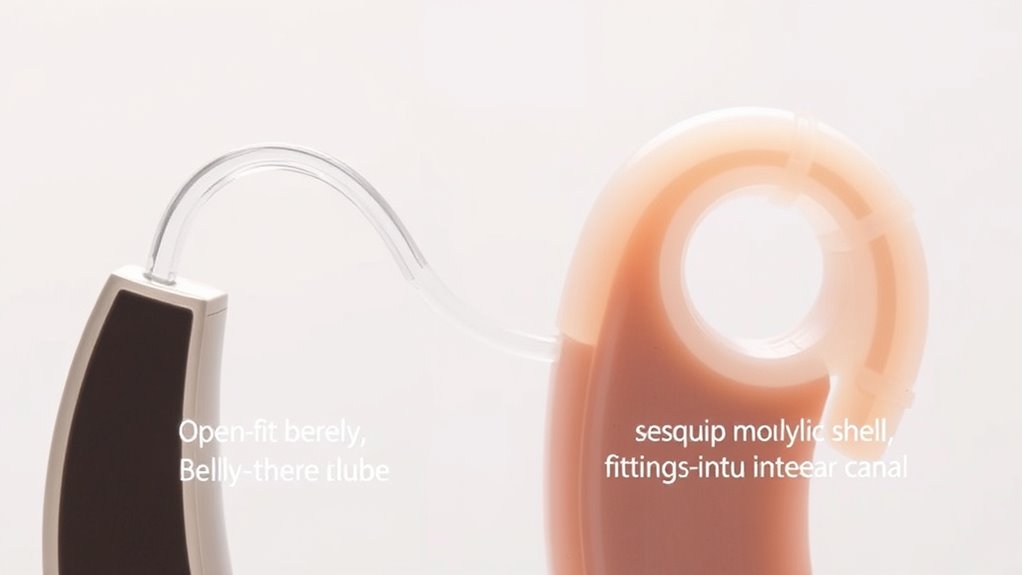
Open-fit hearing aids are designed to sit comfortably behind your ear, with a thin tube that directs sound into your ear canal. These devices typically offer impressive battery life, helping you go longer between charges or battery replacements. Their discreet design enhances aesthetic appeal, making them less noticeable than traditional models. Because they’re open at the tip, they allow natural sound to enter, reducing the feeling of being plugged up. This setup is ideal for those with mild to moderate hearing loss. You’ll appreciate how lightweight and unobtrusive they are, allowing for a more natural hearing experience without sacrificing style. Additionally, the open design helps in reducing sound feedback, making conversations clearer and more comfortable. Overall, open-fit hearing aids balance practicality and appearance, making them a popular choice for daily use.
Exploring Custom Mold Hearing Aids
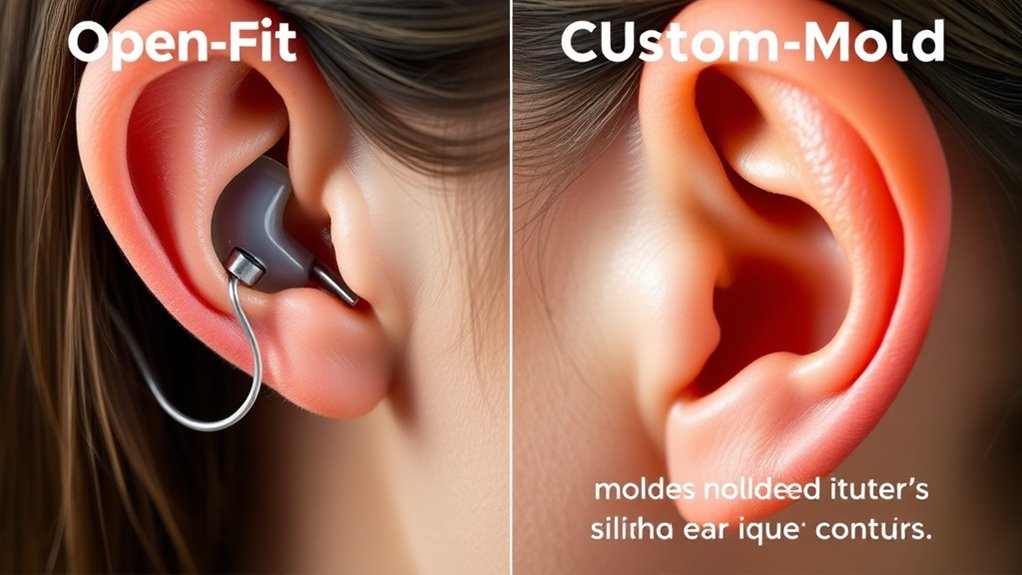
Custom mold hearing aids are tailored to fit your ear perfectly, offering increased comfort and a secure fit. They often provide better sound quality and allow for more precise adjustments to meet your hearing needs. Plus, you can choose from various customization options to make your device uniquely suited to you. Additionally, advancements in AI technology are helping manufacturers improve fit accuracy and customize devices more effectively.
Comfort and Fit
Because they are crafted specifically for your ears, custom mold hearing aids often offer superior comfort and a secure fit. You’ll notice they stay in place better, reducing discomfort during daily activities. The aesthetic appeal is also enhanced since the custom shell fits seamlessly, making them less noticeable. However, consider the cost considerations, as custom molds tend to be pricier than open-fit options. The tailored fit minimizes irritation and pressure points, providing long-lasting comfort. To help visualize, here’s a quick comparison: personalized fit can significantly improve overall satisfaction with your hearing aids.
Sound Quality Benefits
The sound quality you experience with hearing aids can vary markedly depending on the shell type. Custom molds often provide a better seal, which helps deliver clearer, more natural sound by reducing background noise and feedback. This improved acoustic performance can enhance your overall listening experience, especially in challenging environments. Additionally, because custom molds fit snugly, they generally offer better battery life since less power is lost through sound leakage. They also tend to have a higher aesthetic appeal, blending seamlessly with your ear’s shape and reducing visibility. The precise fit not only boosts sound quality but also ensures consistent performance over time, making custom molds a solid choice if sound clarity and reliability are priorities.
Customization Options
Exploring the customization options for mold hearing aids reveals a range of features designed to enhance your comfort and listening experience. Custom molds can be tailored to fit the unique shape of your ear, providing a secure fit and improved sound delivery. When considering these options, think about pricing considerations, as custom molds tend to be more expensive upfront but may offer better durability and comfort over time. Additionally, you can choose aesthetic preferences, such as color or transparency, to make your hearing aids less noticeable or match your personal style. Custom molds also allow for specific modifications to address individual hearing needs, ensuring ideal performance. The material durability of custom molds is an important factor to consider, as it impacts the longevity of your investment. Ultimately, these customization options help you find a solution that balances comfort, appearance, and functionality for your lifestyle.
Comfort and Fit: Open‑Fit Vs Custom Molds

When choosing between open‑fit and custom molds, your fit options and comfort levels are key considerations. Custom molds offer precise sizing and a secure feel, while open‑fit designs are often more comfortable for everyday wear. Think about which style feels better and is easier to put on and take off for your daily routine. Additionally, considering the fit and comfort of your helmet or gear can impact your overall experience and safety during activities.
Fit Customization Options
Since comfort and fit are essential for a satisfying hearing experience, understanding how open-fit and custom mold options differ can help you make the right choice. Custom molds offer personalized fit options, molded precisely to your ear shape, which can improve wireless connectivity by reducing feedback and ensuring a secure connection. They often provide a more consistent fit, minimizing the need for adjustments. Open-fit designs, on the other hand, typically feature less customization, relying on a universal shape that may not fit every ear perfectly but allows for easier insertion and removal. When it comes to battery life, custom molds might slightly extend usage since their secure fit reduces the need for frequent adjustments or re-insertion. Additionally, celebrity lifestyle insights reveal that some users appreciate the aesthetic flexibility of open-fit models, which can be less conspicuous. Ultimately, your choice depends on your desire for personalization and convenience.
Comfort Level Differences
Your comfort level with open-fit and custom mold hearing devices depends on how well each design fits your ear and feels during extended wear. Open-fit styles are lightweight and minimally invasive, often providing a more natural feel, which many find comfortable for daily use. They tend to be less intrusive and allow for better airflow, reducing ear discomfort over time. When considering comfort, also think about aesthetic appeal—custom molds are discreet but take time to produce—and cost considerations, as custom options usually come with a higher price tag. Additionally, understanding your spiritual energy and how it interacts with your environment can influence your overall comfort and well-being during device use.
Ease of Wearing
Choosing between open-fit and custom mold hearing devices largely depends on how easily you can put them on and how secure they feel during wear. Open-fit models are lightweight and slip in quickly, making them ideal if you want convenience. Custom molds, on the other hand, require a fitting session but provide a snug, tailored fit that stays secure. Your aesthetic preferences also matter; open-fit devices are less noticeable, while custom molds can be discreet or more visible, depending on your choice. Pricing options can vary; open-fit options are often more affordable upfront, but custom molds may offer longer-term comfort. Consider this table to weigh ease of wearing:
| Feature | Open-Fit | Custom Mold |
|---|---|---|
| Ease of Wearing | Quick, simple insertion | Slightly more complex |
| Fit Security | Moderate | Very secure |
| Aesthetic Options | Less noticeable | Fully customizable |
Additionally, proper fitting can significantly enhance comfort and ensure optimal hearing performance.
Sound Quality and Noise Isolation Differences
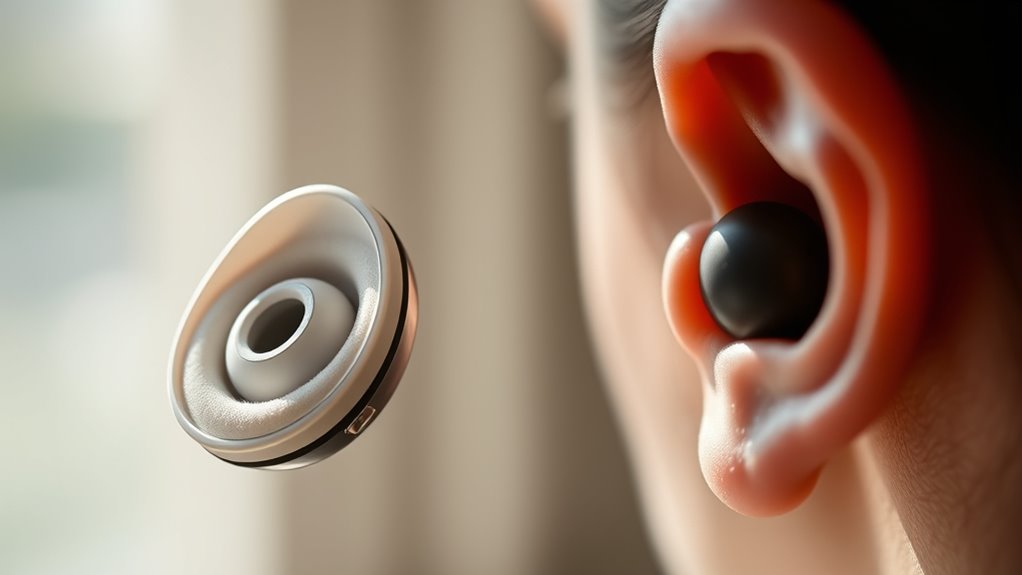
When it comes to sound quality and noise isolation, the type of shell you choose makes a significant difference. Open-fit shells allow more ambient sound in, which can reduce overall noise isolation and sometimes impact clarity. Custom molds fit snugly, providing better sound isolation by sealing your ear canal, resulting in clearer audio and less external noise. This can enhance your listening experience, especially in noisy environments. Additionally, high-quality shells can improve overall comfort during extended use. However, better noise isolation often means more battery drain, as your device works harder to deliver full sound levels. Cost considerations also play a role: custom molds tend to be pricier upfront, but their improved sound quality and noise blocking can justify the investment. Ultimately, your choice depends on balancing sound needs, noise control, battery life, and budget.
Maintenance and Durability Considerations
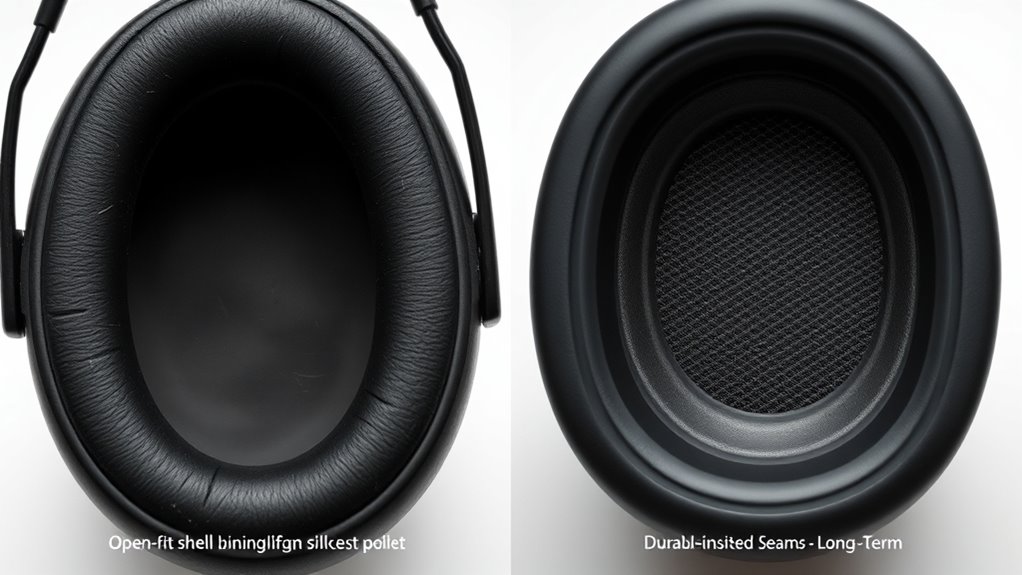
While sound quality and noise isolation are essential, maintaining your ear shells guarantees they perform well over time. Proper care helps extend durability and maximize battery life, especially for open-fit models with rechargeable components. To keep your shells in top shape, consider these factors:
- Regularly clean your shells to prevent earwax buildup.
- Check for cracks or damage that might increase repair costs.
- Avoid exposing them to extreme temperatures, which can degrade materials.
- Replace components like ear tips or batteries as needed to maintain optimal performance and avoid costly repairs.
- Implementing proper maintenance routines can also enhance user comfort and prolong the lifespan of your hearing devices.
Making the Best Choice for Your Lifestyle

Your lifestyle plays a crucial role in determining which ear shell type suits you best. If you’re always on the go and worry about battery life, open-fit shells often use less power, helping your device last longer. They also tend to be less intrusive, offering a natural look that appeals to those valuing aesthetic appeal. On the other hand, if you prefer a secure fit for active routines or long wear, custom molds provide a snug, comfortable fit that stays put, although they might require more maintenance. Consider how often you use your device and your aesthetic preferences. If sleek design matters most, custom molds can be discreet and personalized. Ultimately, matching your lifestyle with these factors ensures you select the shell that enhances your daily comfort and functionality.
Frequently Asked Questions
Can Open-Fit and Custom Molds Be Used Together?
Yes, open-fit and custom molds can be used together through dual compatibility options. This combined usage allows you to switch between open-fit and custom molds easily, depending on your needs. If your hearing aids support dual compatibility, you can enjoy the flexibility of using both shells, providing comfort and improved sound quality. Just verify your device is designed for this feature to maximize benefits without any compatibility issues.
Are Open-Fit Hearing Aids Suitable for Severe Hearing Loss?
If you have severe hearing loss, open-fit hearing aids might not always be suitable, as they typically provide less amplification than other styles. You should consider device compatibility with your level of hearing loss, and consult your audiologist for the best fit. While open-fit options are comfortable and discreet, for severe loss, custom molds or behind-the-ear devices may offer better amplification and clearer sound.
How Quickly Can Custom Molds Be Made?
Custom molds typically take about one to two weeks to manufacture, depending on your specific needs. The manufacturing turnaround involves a thorough customization process, where your ear impression is carefully crafted to guarantee a precise fit. You’ll work closely with your audiologist during this process, which helps create a mold tailored to your ear shape, providing comfort and ideal hearing aid performance.
Do Open-Fit Aids Require Special Cleaning?
Cleaning open-fit aids might seem simple, but neglecting hygiene practices can lead to buildup and germs. Unlike custom molds, which often require professional maintenance, open-fit devices need regular cleaning maintenance at home. You should wipe them daily with a damp cloth and avoid exposing them to water or harsh chemicals. Proper hygiene practices guarantee your device stays clean, comfortable, and effective, so don’t skip this important step.
Are There Aesthetic Differences Between Open-Fit and Custom Molds?
You might notice aesthetic differences between open-fit and custom molds. Open-fit hearing aids often have a more visible, less discreet look, which can affect their aesthetic appeal. In contrast, custom molds are designed to fit snugly and blend more seamlessly with your ear, offering better cosmetic differences. Your choice depends on whether you prioritize a discreet appearance or easier in-the-moment removal and comfort.
Conclusion
So, whether you choose open-fit or custom molds, remember it’s all about finding your perfect “ear” match. After all, who needs comfort or sound clarity when you can have the thrill of constant ear adventures? Just pick the shell that suits your style—because nothing says “I’ve got my hearing sorted” like a fashionable, mismatched ear gadget. Ultimately, it’s your call—just don’t forget to actually hear the world around you.


